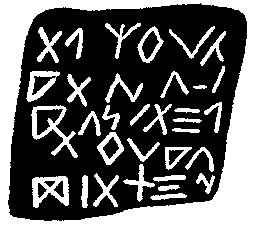 |
Science Frontiers ONLINE No. 98: Mar-Apr 1995 |
|
|
Translating The Grand Traverse Stone
The Grand Traverse Stone was plowed up about 1877 on a farm in Grand Traverse County, Michigan. A small boy following his father and plow picked it up. The stone is slate, ½-inch thick, and 2½ inches on each side. The symbols on the Stone are similar to those in the Pan-Mediterranean alphabet in use about the time of Christ

|
"(I am) carrying (in accounts), 10 talents. To 10 (add) 1 voided (or useless). I am collecting (or sending) 11 only, 10 (of which) I can confirm. Transaction (is) 11 in all (or total)."
The Grand Traverse Stone therefore seems to be a financial document of some kind. Buchanan dates it between 100 BC and 100 AD.
(Buchanan, Donal B.; "Some Remarks on an Inscribed Stone from Grand Traverse Country, Michigan" NEARA Journal, 28:100, 1994. NEARA = New England Antiquities Research Association.)
Comment. The Grand Traverse Stone is just one of hundreds of tablets, coins, and inscriptions on stone walls that suggest European contacts with the New World in ancient times. Of course, mainstream archeologists dismiss all as deliberate frauds or objects imported and dropped accidentally by post-Columbian settlers. The Grand Traverse Stone suggesting organized trade with the New World 2,000 years ago is particularly anomalous.